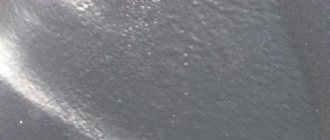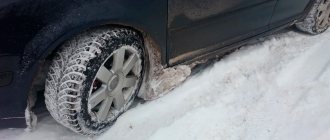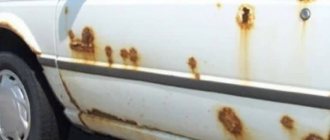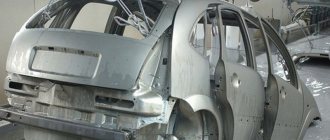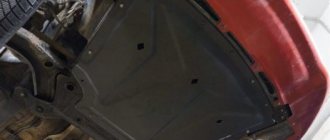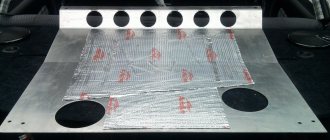Car thresholds (boxes) are one of the most problematic body elements after wheel arches. As a rule, arches, sills, and door edges are often damaged and are most susceptible to corrosion.
To protect thresholds, the following procedures must be carried out:
- internal threshold processing;
- external threshold protection.
Please note that these operations are carried out comprehensively. Internal treatment should be carried out to protect internal (hidden cavities) from moisture. External treatment involves protecting the paintwork of the threshold from chips and other damage in order to avoid the onset of active corrosion. Read more in our article.
Why do you need to additionally process thresholds?
Modern cars usually have minimal sill protection when leaving the factory. At the same time, thresholds for cars are often treated at the factory with “anti-gravel”, which is painted on top in the color of the body. Less often, some models additionally receive plastic door sills, etc.
It is important to understand that regardless of the type and quality of protection, during vehicle operation, thresholds require special attention for the following reasons:
- when getting in and out of a car, the threshold is often caught by shoes, damaging the paintwork;
- stones and sandblasting cause paint chips and deep scratches on the thresholds;
- collisions with obstacles, high curbs, errors when working with a lift or jack often lead to jamming of the thresholds;
- the adhesion of snow and ice mixed with salt and chemical reagents leads to active corrosion;
- insufficient ventilation of the thresholds leads to hidden internal corrosion of the closed box;
In all cases, the main problem is unprotected metal, which quickly begins to rust in winter. For these reasons, it is necessary to protect the thresholds from corrosion. Otherwise, you will need to replace the threshold, which is much more expensive than protecting the boxes.
Varieties by number of components
An important performance characteristic of a primer is its drying speed.
This indicator depends on the use of additional components when composing the mixture: filler, hardener, various chemical additives and elements.
Based on this criterion, soils are divided into 3 groups:
- One-component. They go on sale ready-made. Before starting work, just stir them until they have a homogeneous consistency. They are used extremely rarely in auto repair shops and service stations due to the long drying period (several days).
- Two-component. Before use, they require adding a hardener, which saves a lot of time when working. Dries in 24 hours.
- Ethanol. Used to eliminate defects in minor damage. They use the ability of alcohols to quickly evaporate, which allows the composition applied to the surface to dry within 1 hour. In both soft and hard consistency, they are convenient for application and subsequent sanding.
How to treat thresholds from the inside
To protect car sills from corrosion inside the boxes, you need to perform anti-corrosion treatment. In this case, you can use both ready-made anti-corrosion compounds (for example, Rust-Stop for hidden cavities), and the well-known Movil in thresholds or other solutions.
At the same time, experts recommend using professional solutions, since they tend not to dry out, have good fluidity and covering power of surfaces, contain special corrosion inhibitors, etc.
The main task comes down to effectively spraying a protective agent inside the box, which will then protect the metal (often untreated) and displace moisture. The treatment can be done through special technological holes, which are made in the car boxes for ventilation (can be hidden behind mudguards and fender liners).
Types of corrosion
There are two types of corrosion that can affect car sills:
- chemical – oxygen and hydrogen contained in water are natural oxidizing agents, which creates conditions for corrosion;
- electrochemical - water containing salts and gases, falling on the surface of the metal, causes an electric current, which initiates the formation of corrosion.
The metal surface can be subject to destructive effects and two types of corrosion at the same time. Therefore, it is very important to protect all elements of the car from their negative effects. Various tools and technologies that you can do yourself can help with this.
External protection of car thresholds
In addition to internal protection, thresholds must be treated externally. For these purposes, you can use various means. As a rule, these are the following compositions:
- anti-gravel for thresholds;
- special mastic;
- anti-corrosion agents.
Such coatings can be purchased in aerosol cans; there are also “brush” or “gun” solutions. The protection is applied from above, that is, directly onto the primer, paint or varnish.
- The easiest and fastest way is to apply a ready-made anti-corrosion agent to the thresholds without painting or any additional processing.
- A more complex method is anti-gravel treatment, which can be combined with subsequent coating with paint or varnish to obtain a gloss effect (the main thing is to choose compositions that can be treated with paint or varnish);
- To obtain a durable and thick protective layer, it is optimal to use the method of treatment with anti-corrosion mastic. In this case, the surface will need to be prepared in advance so that the protective coating adheres well to the thresholds.
Another option is a protective anti-gravel armor film on the car, which is glued to the threshold after it has been treated with a suitable composition or painted. This method is especially in demand if you had to buy a threshold and install it on a car, paint the thresholds, after which protection is also required while completely preserving the appearance of the freshly painted element.
Causes of rust
Before you start fighting rust on the surface of your car, you should know the reasons for its appearance. Corrosion appears in those areas from which the paint that protects the metal has come off. Most often, coating failure occurs due to mechanical damage. So, while the car is moving, small pebbles fly out from under the wheels and hit the thresholds. During the impact, they knock the paint off the surface, where red spots appear. In winter, the situation is aggravated by salt, which further corrodes the damaged areas.
How to process thresholds with your own hands
For independent external treatment of thresholds, it is better to choose a simple method with anti-gravel in an aerosol can. Before treatment, you must wash the car and dry the car. It is better to carry out all work on a lift or overpass.
You should also prepare tools and materials:
- metal cleaning brush;
- sandpaper with “fine” and “medium” grain;
- anti-gravel;
- degreaser (White Spirit will do);
- rust converter;
- construction hair dryer;
- masking tape;
- container with clean water and rags.
Preparation of thresholds
First, use sandpaper to remove rust from the metal on the thresholds. Next, all areas will need to be treated with a rust converter and dried.
Then all areas that will not be treated are covered with masking tape. At this point, preparation for processing is completed and you can proceed to applying the protective composition.
We also recommend reading the article about how to treat the underbody of a car to protect against corrosion. From this article you will learn about the available methods for treating the bottom to protect against rust.
Application of anti-gravel
- Before spraying, shake the aerosol can well for a couple of minutes;
- It is necessary to spray the product onto the threshold from a distance of about 20 cm;
- It is necessary to spray so that the composition lies evenly on the surface;
- After applying the first layer, you must wait about 10 minutes;
- To form the coating, it is necessary to apply at least 3 layers;
- After finishing the treatment, the anti-gravel is dried with a hair dryer.
Once the drying phase is complete, the masking tape can be removed. It is not recommended to operate the car immediately after treatment. It is necessary to wait about 2-3 hours for the protective material on the thresholds to dry completely.
Let us also add that if mastic was used instead of anti-gravel, which is applied with a brush, such material cannot be dried with a hairdryer. The mastic on the thresholds should dry on its own. Typically the drying process ranges from 2-3 to 10-12 hours.
Nuances of choosing purchased processing products
When choosing anti-corrosion body protection products, the characteristics of the product are strictly checked: purpose, shelf life, interaction with auxiliary materials, indications for application. The product is supplied in cans or metal cans, depending on the composition and method of application to the cavities of the car.
The chemical composition of both expensive and more economical anticorrosive agents is aggressive and dangerous to the human body. Therefore, the use of rubber gloves and closed clothing is mandatory.
The range of corrosion inhibitors is very wide. They differ in application methods, composition components, environmental resistance, drying time, and price indicators. Alternative options for anti-gravel are:
- Used technical oil. Used in older car models. It has a strong unpleasant odor and low environmental friendliness.
- Movil. Anti-corrosion inhibitor of liquid structure. Named after two cities (Moscow and Vilnius). Created in the middle of the last century as the main means of overcoming rust in car components. The composition includes oils, kerosene, drying oil and a small percentage of specific additives.
- Special mastics based on rubber. The composition contains certain types of resins. They are distinguished by increased viscosity, labor-intensive application process, and increased temperature requirements for use.
Recommendations
- It should be taken into account that it is quite difficult to buy a high-quality threshold for a car if a replacement is necessary. For this reason, it is better to take care of the body and individual elements than to carry out expensive body work and replacement of thresholds. It should be remembered that without treatment and protection, the sills, even on a new car with minor damage, can rot within 4-5 years.
- If any repairs to the thresholds were carried out (installation of patches, welding, pulling), the repair site must be additionally processed both outside and inside.
Otherwise, the repair areas will be subject to corrosion after a short period of time. We also recommend reading the article on how to remove rust from a car body. From this article you will learn about available ways to remove rust from a car body with your own hands. - During the operation of the car, it is necessary to periodically remove the mudguards and linings to clean out dirt, debris, leaves, sand particles in the sill area, etc. This will protect against premature corrosion in these places and will normalize the ventilation of the box.
- To prevent snow and ice from sticking to the sills and fender liners in winter, these elements can be treated with compounds such as WD-40. The formed greasy film repels moisture and snow, preventing the formation of ice in the fender liners and in the area of the mudguards. Also, the lower part of the threshold can be treated with silicone grease.
Treatment of hidden threshold cavities should be performed at least once every 2-3 years. At the same time, the old “old-fashioned” methods like pouring “working out” into the thresholds, Moville with cannon fat, etc. may be less effective than using modern solutions.
It is better to treat the thresholds from the inside with special compounds with corrosion inhibitors, which, after application, spread most effectively over the entire surface of the box and protect the metal of the box.
Anticorrosive recipe
The presented products narrow the field of activity for experienced car enthusiasts. The best way to correct the imbalance is to make anticorrosion compound yourself. The complex action of the constituent parts, the consistency of the substance and the volume will definitely satisfy the car owner.
The value of the recipe lies in the availability and cost-effectiveness of most ingredients. The composition is based on bitumen or wax compounds. They envelop the metal of the body and hold the entire mass on the surface. The main option is cannon fat. This is a long-established remedy, trouble-free, low-cost, and commercially available.
The availability of auxiliary components depends on the needs of the master. May include:
- Plasticine. Strengthens the structure, adds plasticity and comfort during processing.
- Waterproofers. Protects against water ingress and rust during operation.
- Anti-corrosion inhibitors. Chemical retardants of the destructive process of rotting of metal parts.
To increase efficiency, metal particles are introduced into the composition for strength (zinc, bronze), plastic or rubber compounds, glue or sealant for additional protection of problem areas.
Will regular paint help?
The composition and properties of conventional paints and varnishes do not allow their use as an alternative to anti-gravel. The absence of anti-corrosion inhibitors eliminates the creation of a protective film and allows the action of chemically aggressive reagents and water to spread. The paint fades quickly, does not prevent the spread of rust, and does not eliminate existing problem areas. Water-repellent properties are at a low level.
What defects may there be?
The procedure and specifics of work when restoring car thresholds depends not only on their type, but also on the damage received.
Damage that can be repaired without welding:
- shallow dents without sharp edges;
- chips of paint coatings due to small pockets of corrosion;
- pinholes caused by corrosion.
Rotten metal thresholds can only be repaired by welding. It is advisable to repair removable elements only in case of minor damage, which can be easily repaired on your own. If the defects are significant, it is better to replace the removable spare part with a new one, since the price of analogues and the cost of repair work are almost equal.
List of materials
Here we answer the question of how to paint car sills to protect them from corrosion. The easiest option is to apply a protective composition without painting it. The result will look like below:
Anti-gravel protection without painting
The anti-gravel layer itself can be varnished. This is done to get a glossy surface. By the way, many anti-gravel compounds do not allow the use of varnish and paints - after application, a film is formed that has elasticity. In general, you need to have an exact idea of what exactly should happen in the finale.
The finished layer of anti-gravel coating, if it was applied several days ago, cannot be varnished - it is better to leave everything as is, or paint it.
Before applying anti-gravel, the surface must be degreased. For this, solvents that do not contain acetone are used. Use solvent. You will also need P400-P1000 sanding paper. It is used for matting.
There is widespread advice that any anti-gravel needs to be varnished. Perhaps for some materials this is 100% true. However, the choice remains with the owner. You can choose a material that does not require additional protection.
